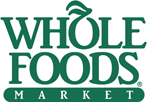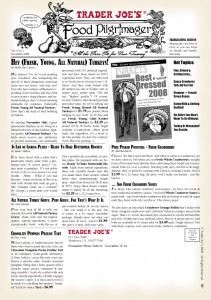fan of joe’s
Last week, Whole Foods announced its dismal 4th quarter results — net income for the quarter fell 96% to $1.5M and comparable store sales (the key metric for retail business health) increased only 0.4% vs. an 8.2% increase in the prior year. My colleague, John Moore, said it best when describing the results as “downright ugly.”
announced its dismal 4th quarter results — net income for the quarter fell 96% to $1.5M and comparable store sales (the key metric for retail business health) increased only 0.4% vs. an 8.2% increase in the prior year. My colleague, John Moore, said it best when describing the results as “downright ugly.”
The news made me wonder how Whole Foods’ brand nemesis, Trader Joe’s,  is doing in these tough times for retailers. Since TJ’s is privately held, it’s difficult to find any information about their current performance. But a BusinessWeek article last February reported TJ’s sales at an impressive $6.5 billion in last year and said the consulting firm TNS Retail Forward estimated the chain generates sales in the neighborhood of $1,300 per square foot, double the supermarket industry average.
is doing in these tough times for retailers. Since TJ’s is privately held, it’s difficult to find any information about their current performance. But a BusinessWeek article last February reported TJ’s sales at an impressive $6.5 billion in last year and said the consulting firm TNS Retail Forward estimated the chain generates sales in the neighborhood of $1,300 per square foot, double the supermarket industry average.
And if my local TJ’s is any gauge, the company is weathering the economic storm just fine — the aisles are still packed with savvy shoppers pretty much any time/day I’m there and I haven’t seen the price increases that other retailers have tried to sneak in. If anyone has any information on TJ’s business performance, I’d love to hear it.
For now I thought I’d use this post to submit what I believe has made TJ so successful that it appears to be recession-proof — and that is, of course, it’s brand. The company has carefully and consistently built its brand using 3 levers:
– discriminating selection — like any specialty retailer, the value of the TJ brand is primarily its editing — that is, reducing the number of millions of choices in the world down to the ones that are right for its target market — in some cases, that means selecting the one offering that will meet the needs of most (you’ll find just one kind of laundry detergent at TJs); in others, that means providing a wide selection in a hot category to provide innovation and choice to its customers (they have 10+ kinds of hummus — including a chipotle variety which I highly recommend!) TJ’s demonstrates its customer intimacy by getting its selection right.
— including a chipotle variety which I highly recommend!) TJ’s demonstrates its customer intimacy by getting its selection right.
– superior private label — TJ’s has known all along what most retailers are just now figuring out — that is, private label is not just a way to provide lower priced products to customers — it’s a means for introducing products that are innovative, higher-quality, and most importantly, exclusive to the outlet. The lower price is just the icing on the private-label-as-brand-builder cake. Through these offerings, TJ has established the eco-friendly, wholesome/natural, and ethnic taste attributes of its brand.
– “no-fluff” personality — from its  quarterly Fearless Flyer published on newsprint to those hand-written shelf talkers to its zero-attitude products like Two-Buck Chuck (er, I mean, Charles Shaw wine), TJ’s no-frills, no-fluff brand personality comes through everything they do. By operationalizing their brand attitude through their products, merchandising, employee uniforms, service approach (e.g., the way they conveniently pack 100 things into one shopping bag without mis-handling or squashing any of them), etc., TJ’s creates a distinct and compelling shopping experience. Have you ever noticed that no other store looks or feels quite like a Trader Joe’s? And don’t you feel a little smarter, a little more in-the-know when you shop there?
quarterly Fearless Flyer published on newsprint to those hand-written shelf talkers to its zero-attitude products like Two-Buck Chuck (er, I mean, Charles Shaw wine), TJ’s no-frills, no-fluff brand personality comes through everything they do. By operationalizing their brand attitude through their products, merchandising, employee uniforms, service approach (e.g., the way they conveniently pack 100 things into one shopping bag without mis-handling or squashing any of them), etc., TJ’s creates a distinct and compelling shopping experience. Have you ever noticed that no other store looks or feels quite like a Trader Joe’s? And don’t you feel a little smarter, a little more in-the-know when you shop there?
So, as a customer and a brand person, I’m a TJ’s brand fan — I suspect there might be a few million others out there as well.